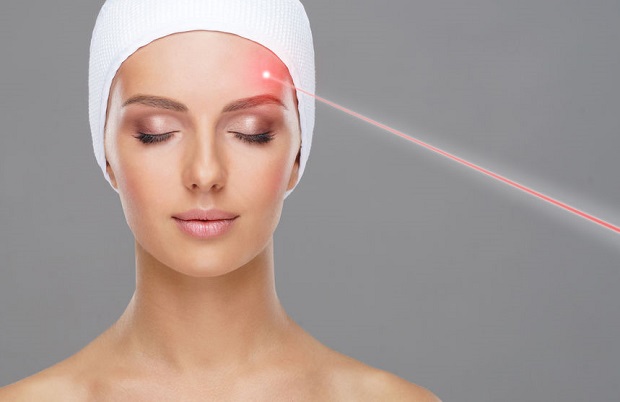
Most birthmarks do not require treatment. However, for those that do, there are a variety of professional birthmark removal methods that modern physicians perform. The method that your physician recommends will depend on the type of birthmark, its size, its location, your age, and general health. Here are a few currently available methods and a few future possible treatment options.
Laser Surgery
Laser surgery involves the use of a high-energy laser that lightens the affected area. It is most effective on birthmarks close to the skin’s surface, like port wine stains. Because birthmarks can become raised and bumpy with age, laser treatment is often recommended for children. Laser surgery is typically performed in a doctor’s office under general or local anesthesia, depending on the birthmark size and location. The size and location will also dictate the number of sessions required for optimal results. ((National Health Service – “Birthmarks“))
Possible side effects: bruising, pain, and increased sensitivity to sunlight. ((National Health Service – “Birthmarks“))
May be used to treat: hemangiomas, port wine stains, nevus of ota, and Café-au-lait spots ((Cleveland Clinic – “Mole Removal“))
Cost Consideration: Laser treatments, in general, are listed as one of the top six affordable treatments by the American Academy of Facial Plastic and Reconstructive Surgery or AAFPRS. ((American Academy of Facial Plastic and Reconstructive Surgery – “Yes You Can Afford Plastic Surgery“))
Additionally, the AAFPRS considers laser treatments as an effective non-invasive procedure that can remove blemishes such as birthmarks, as the laser energy can make the discolored skin fade and blend with the original skin color. Laser birthmark removal can require a number of treatments until the patient’s goal is met, depending on the kind of birthmark involved as well as its size and depth. For example, treating a port wine stain may take ten or more treatments with a one to two-month waiting period between sessions. ((Oregon Health & Science University – “Cosmetic Laser Services for Birthmarks and Red Marks“))
Topical or Injected Corticosteroids
Corticosteroid medications can effectively treat hemangiomas, a collection of blood vessels that can appear as a bright, red patch or lump on the skin. The corticosteroids act on the stem cells reducing their ability to produce new blood vessel growth that is responsible for the birthmark’s growth. ((Boston Children’s Hospital – “Hemangioma“))
Most hemangiomas do not require treatment and will eventually resolve on their own, but may require treatment if they are obstructing vital functions such as obstructing airways or vision.
Possible side effects: high blood sugar, high blood pressure, poor growth, and cataracts. ((Mayo Clinic – “Hemangioma – Treatment and Drugs“))
May be used to treat: hemangiomas.
Topical or Oral Beta Blockers
Beta-blockers tighten blood vessels restricting blood flow. This blood flow restriction helps reduce the size and color of hemangiomas. Beta-blockers also affect the cells that cause the birthmark to grow. ((National Health Service – “Birthmarks“))
Possible side effects: slow heart rate, low blood pressure, bronchospasm, weakness and fatigue, sleep disturbance, and low blood sugar. ((National Health Service – “Birthmarks“))
May be used to treat: hemangiomas.
Cryosurgery
Cryosurgery, also called cryotherapy, is an effective treatment for a variety of skin conditions, including skin tags, age spots, and warts. It is also sometimes indicated as an alternative treatment for birthmarks. ((University of Maryland Medical Center – “Birthmarks – Red“)) The cryosurgery procedure involves the use of liquid nitrogen or argon gas to freeze an area of skin cells, which will die and slough off as a result. ((American Family Physician – “Cryosurgery for Common Skin Conditions“))
Possible side effects: blister formation, bleeding, hair loss, headache, and hypopigmentation. ((American Family Physician – “Cryosurgery for Common Skin Conditions“))
May be used to treat: hemangiomas.
Surgical Excision
Surgical excision may involve excision with or without stitches or excision with cauterization. The procedure is commonly performed to remove moles but less frequently for birthmark removal. ((Medicine – “Mole Removal Surgery“))
Possible side effects: scarring, infection, nerve damage. ((Medicine – “Mole Removal Surgery“))
May be used to treat: pigmented birthmarks and hemangiomas in rare cases. ((Cleveland Clinic – “Mole Removal“))
Future Treatment Options for Birthmark Removal
Topical Immune Suppressants: One study has had success with the topical cream imiquimod. According to research published in Challenges in Medical and Surgical Therapeutics by the AMA, imiquimod is an immune-response modifier that worked successfully to treat typical hemangiomas.
Vascular Birthmark Foundation
New Topical Treatment for Hemangiomas Reported by AMA
http://birthmark.org/node/105
Interferon alpha-2: Interferons modulate the response of the immune system. According to research published in the New England Journal of Medicine, interferon alpha-2 induced early regression of life-threatening infantile hemangiomas that were corticosteroid resistant.
New England Journal of Medicine, Ezekowitz, RA
Interferon alfa-2a therapy for life-threatening hemangiomas of infancy.
1992, Volume: 326, No: 22, pages: 1456-1463
Glossary of Terms
Bronchospasm: constriction of the air passages of the lung (as in asthma) by spasmodic contraction of the bronchial muscles.
Merriam-Webster Dictionary
Corticosteroids: man-made drugs that closely resemble cortisol, a hormone that your adrenal glands produce naturally.
Cleveland Clinic
Hypopigmentation: Deficiency of cutaneous melanin relative to surrounding skin.
Drugs.com
Expert Resources
“In most cases, no treatment is needed for pigmented birthmarks. When birthmarks do require treatment, however, that treatment varies based on the age of the child, the type of birthmark and its related conditions, and its location. Typically surgical excision is the indicated treatment in these cases.”
Birthmarks Cleveland Clinic





